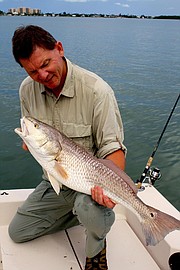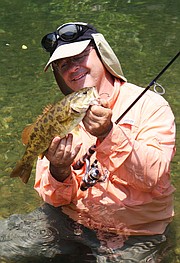Every autumn, I run a column offering advice on how to shoot attractive hunting photos to honor our game.
With all respect to my treasured readers, we clearly need a column about how to photograph fish, too.
I know how excited I get on the rare occasions when I catch a big fish. Those are special, unforgettable moments, and I am deeply honored that you share them with us, and by extension, with the Arkansas Democrat-Gazette outdoors community. With a little care and effort, you can take stunning fishing photos that are worthy of permanent enshrinement in print or on the Internet.
More importantly, it shows respect for a resource that we love and to which we devote so many hours in pursuit.
For those that don't mount their fish, a well-lit, well-composed photograph, blown up big on glossy paper in a nice frame, is a great substitute.
The average fishing photo is an afterthought, usually shot in haste with a smartphone before the angler releases the fish or puts it in a livewell or cooler.
Admittedly, the average fishing boat is not an ideal stage for photography. Your standard aluminum fishing boat is narrow, cramped and tippy. These qualities discourage moving around and positioning models. Still, it's not hard to do, and it doesn't take much time.
Always, the best photography light is early in the morning and late in the afternoon or early evening. The light is soft and deeply saturated, which makes a fish positively glow.
When you catch a nice fish in those hours, position the angler facing the sun to get full lighting. Hold the fish with two hands at a horizontal angle. If it's a toothless fish like a bass, support it with a thumb in the lip and with one hand under the belly, with as little of the hands facing the camera as possible. The hands should be between the fish and the angler's body so that the hands don't compete with or overshadow the fish.
For toothy fish like walleyes or speckled sea trout, secure the front of the fish with a thumb in the back gill plate.
When holding bass, do not support the entire fish by cocking its jaw with a thumb in the lip. This can mortally injure a big bass that you release.
Remove your sunglasses and look down the fish's back toward its eye. This directs attention to the fish, and a viewer's eyes will follow the angler's line of sight to the fish's head. The fish's eye will naturally catch light to complete the effect.
It's cliche to thrust the fish out toward the camera to make it look bigger. Don't do that. Instead, with your elbows wedged against your ribs, cant the fish slightly upwards and away and have the cameraman move in close. This will subtly enlarge a fish in relation to the model.
Tickle the fish's belly with the thumb of the hand supporting the body. This provokes a fish to raise its fins, which makes it look bigger, more dramatic and more alive. Every magazine fish photo looks like that, and tickling the belly is how the photographer got the effect.
Dark caps and shirts, especially red, offer a sharp contrast to a fish.
For context, get a landmark or some other site-specific element in the background. This can be a dam, a bridge or a sign at a marina. I can't tell you how many photos I've taken at Lake Maumelle with The Chimney in the background. Pinnacle Mountain is an unmistakable background at Lake Maumelle and the Arkansas River, as is Sugarloaf Mountain at Greers Ferry Lake.
Anglers love to look at photos of big fish. We love even more to look at great photos of big fish. Send us yours so we can put them in the paper.
Sports on 06/09/2019


